Hand Hygiene Practices and Infection Risk Management in Healthcare
VerifiedAdded on 2022/11/13
|16
|3885
|406
Report
AI Summary
This research proposal examines the critical role of hand hygiene in healthcare settings, specifically focusing on its impact on infection risk management. The study aims to assess the hand hygiene practices of nurses within a healthcare facility, investigating their adherence to self-care protocols and their influence on patient care. The introduction highlights the importance of hospital hygiene and the prevention of nosocomial infections, emphasizing the need for healthcare providers to maintain high standards of hygiene. The literature review incorporates Dorothea Orem's Self-Care Theory, emphasizing the nurse's role as a role model for patients in promoting healthy living. The research methodology involves interviews and observations of nurses, with data analysis aimed at determining compliance with hand hygiene practices. The expected outcome suggests potential deficiencies in current hygiene practices, highlighting the need for improved adherence to hand hygiene protocols to reduce the spread of infections and improve patient outcomes.
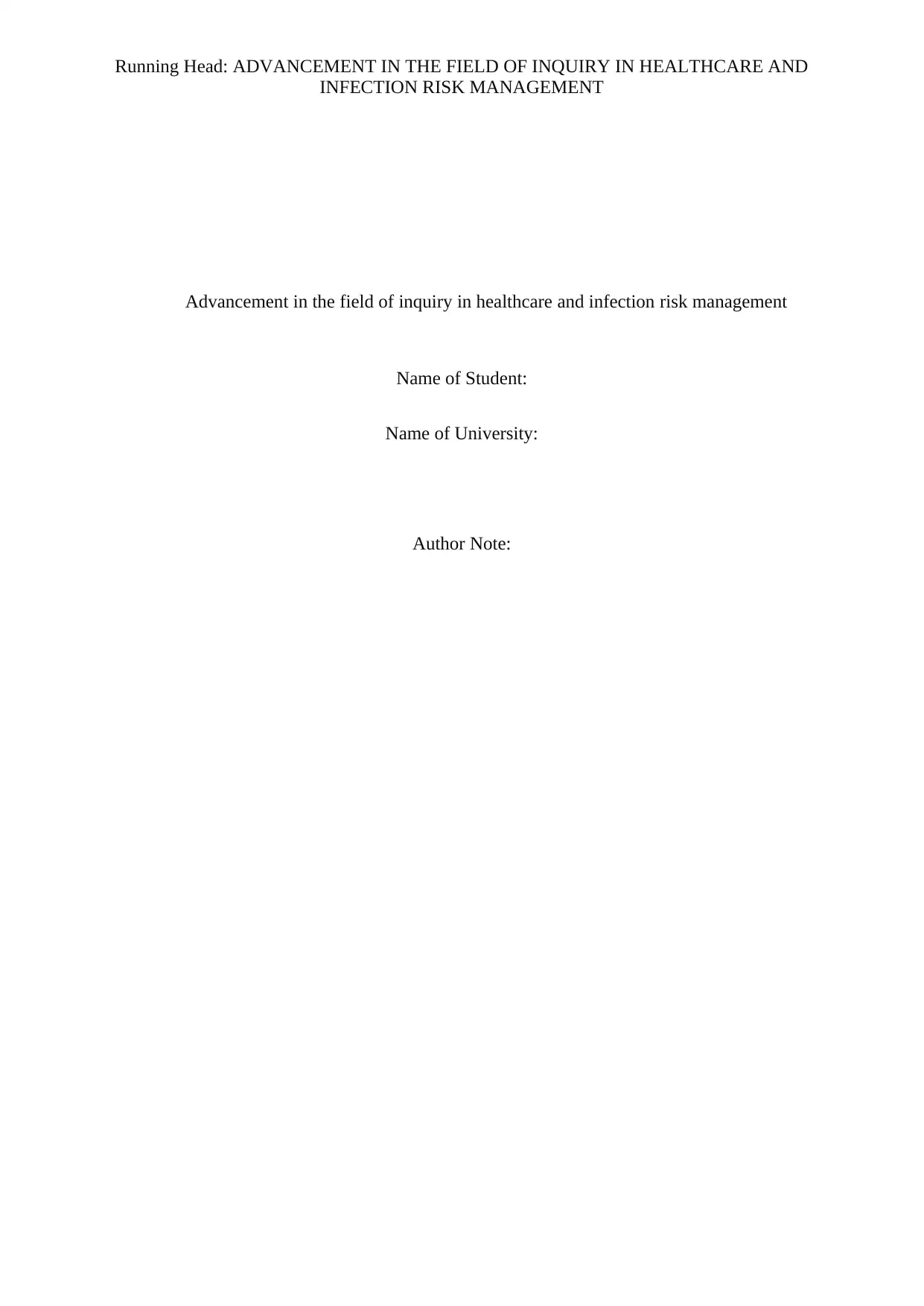
Running Head: ADVANCEMENT IN THE FIELD OF INQUIRY IN HEALTHCARE AND
INFECTION RISK MANAGEMENT
Advancement in the field of inquiry in healthcare and infection risk management
Name of Student:
Name of University:
Author Note:
INFECTION RISK MANAGEMENT
Advancement in the field of inquiry in healthcare and infection risk management
Name of Student:
Name of University:
Author Note:
Paraphrase This Document
Need a fresh take? Get an instant paraphrase of this document with our AI Paraphraser
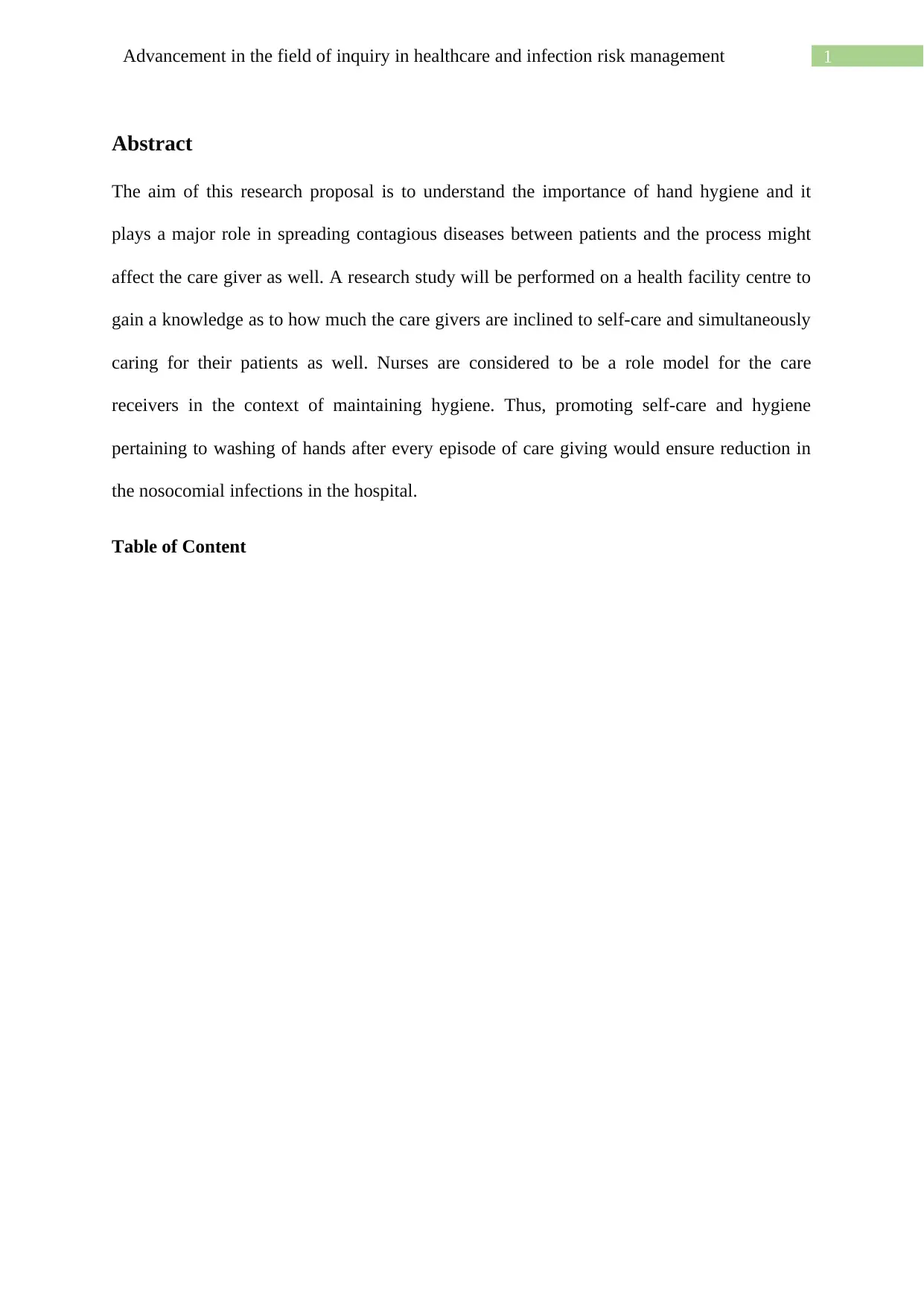
1Advancement in the field of inquiry in healthcare and infection risk management
Abstract
The aim of this research proposal is to understand the importance of hand hygiene and it
plays a major role in spreading contagious diseases between patients and the process might
affect the care giver as well. A research study will be performed on a health facility centre to
gain a knowledge as to how much the care givers are inclined to self-care and simultaneously
caring for their patients as well. Nurses are considered to be a role model for the care
receivers in the context of maintaining hygiene. Thus, promoting self-care and hygiene
pertaining to washing of hands after every episode of care giving would ensure reduction in
the nosocomial infections in the hospital.
Table of Content
Abstract
The aim of this research proposal is to understand the importance of hand hygiene and it
plays a major role in spreading contagious diseases between patients and the process might
affect the care giver as well. A research study will be performed on a health facility centre to
gain a knowledge as to how much the care givers are inclined to self-care and simultaneously
caring for their patients as well. Nurses are considered to be a role model for the care
receivers in the context of maintaining hygiene. Thus, promoting self-care and hygiene
pertaining to washing of hands after every episode of care giving would ensure reduction in
the nosocomial infections in the hospital.
Table of Content
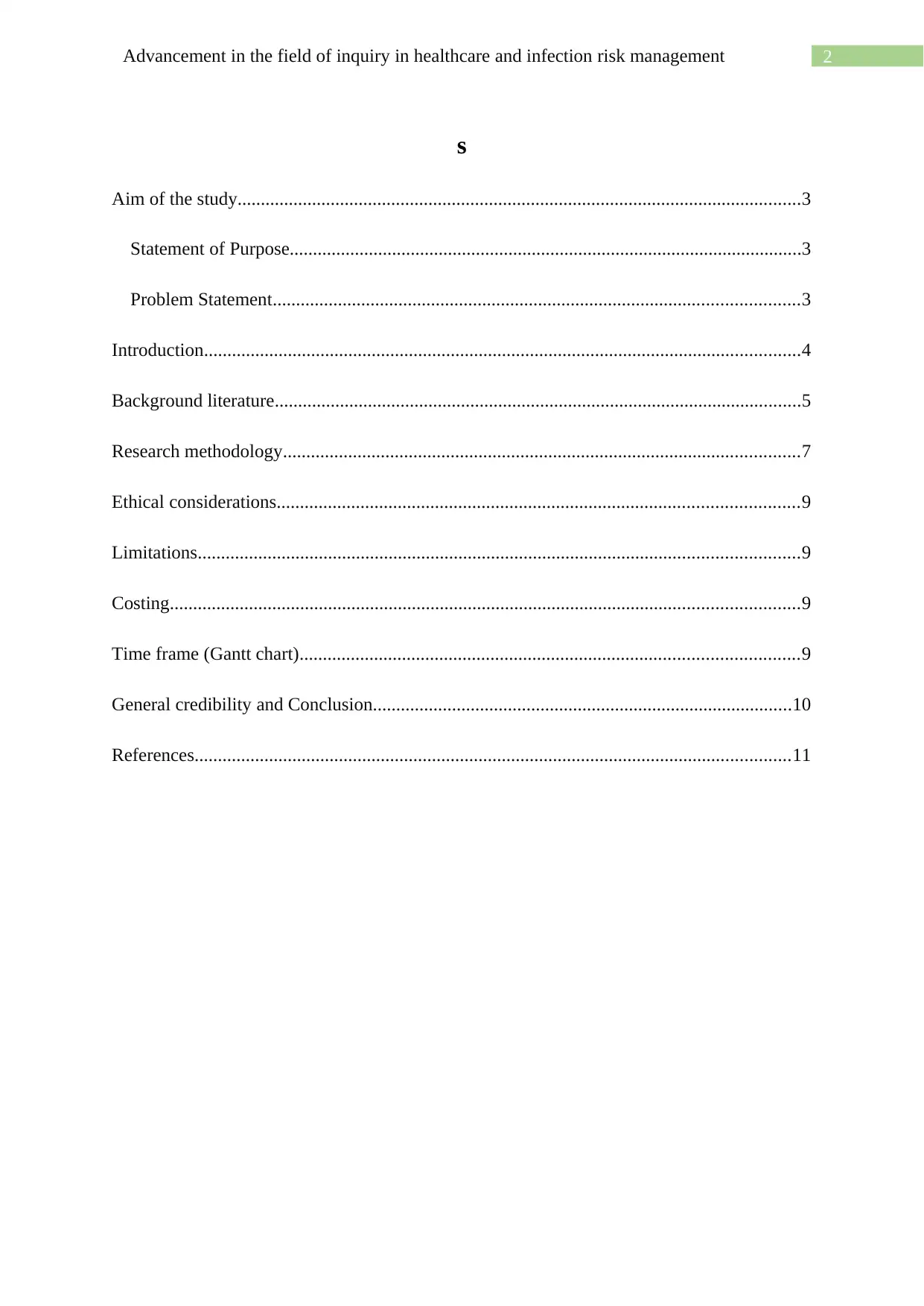
2Advancement in the field of inquiry in healthcare and infection risk management
s
Aim of the study.........................................................................................................................3
Statement of Purpose..............................................................................................................3
Problem Statement.................................................................................................................3
Introduction................................................................................................................................4
Background literature.................................................................................................................5
Research methodology...............................................................................................................7
Ethical considerations................................................................................................................9
Limitations.................................................................................................................................9
Costing.......................................................................................................................................9
Time frame (Gantt chart)...........................................................................................................9
General credibility and Conclusion..........................................................................................10
References................................................................................................................................11
s
Aim of the study.........................................................................................................................3
Statement of Purpose..............................................................................................................3
Problem Statement.................................................................................................................3
Introduction................................................................................................................................4
Background literature.................................................................................................................5
Research methodology...............................................................................................................7
Ethical considerations................................................................................................................9
Limitations.................................................................................................................................9
Costing.......................................................................................................................................9
Time frame (Gantt chart)...........................................................................................................9
General credibility and Conclusion..........................................................................................10
References................................................................................................................................11
⊘ This is a preview!⊘
Do you want full access?
Subscribe today to unlock all pages.

Trusted by 1+ million students worldwide

3Advancement in the field of inquiry in healthcare and infection risk management
Aim of the study
Statement of Purpose
Nurses are care giver ambassadors who should promote a healthy living and imbibe
healthy practices. The most crucial part of healthy living involves hygienic practices which
includes hand hygiene. This should be maintained everywhere at home and at work. They
should aim in promoting the health and hygiene. Hence, patients can easily imbibe these
healthy habits from their care givers and reduce the consequences of poor hygiene. The aim
of this article is to research the hygienic practices that are followed by a particular health
facility centre to establish the knowledge as to whether the nurses adhere to the healthy habits
or they just preach it but do not practice it themselves. It is considered to be an ethical
practice of the nurses to adhere to hygienic practices and effectively set good example to their
subjects who are the patients they are treating and help the patients to imbibe the practices
and result in reducing the chances of infections that occur due to low hygiene (Azim,
Juergens & McLaws, 2016).
Problem Statement
The increasing rate of nosocomial infections mainly the stomach infections is raising
the health alert. The crucial fact being that even the hospital attendants and other workers are
also acquiring the same. This states that if health professionals are infected the ramifications
may be high on the general citizen. Maintenance of high hand hygiene is of prior importance
because contaminated hands can be the root cause of stomach infections (Smith & Liehr,
2018). Many people have a misconception that hand hygiene can be considered a trivial
matter. As a result of which they encounter several health complications. To overcome such
situations and to promote hygienic and healthy self-care and care of their patients as well.
Aim of the study
Statement of Purpose
Nurses are care giver ambassadors who should promote a healthy living and imbibe
healthy practices. The most crucial part of healthy living involves hygienic practices which
includes hand hygiene. This should be maintained everywhere at home and at work. They
should aim in promoting the health and hygiene. Hence, patients can easily imbibe these
healthy habits from their care givers and reduce the consequences of poor hygiene. The aim
of this article is to research the hygienic practices that are followed by a particular health
facility centre to establish the knowledge as to whether the nurses adhere to the healthy habits
or they just preach it but do not practice it themselves. It is considered to be an ethical
practice of the nurses to adhere to hygienic practices and effectively set good example to their
subjects who are the patients they are treating and help the patients to imbibe the practices
and result in reducing the chances of infections that occur due to low hygiene (Azim,
Juergens & McLaws, 2016).
Problem Statement
The increasing rate of nosocomial infections mainly the stomach infections is raising
the health alert. The crucial fact being that even the hospital attendants and other workers are
also acquiring the same. This states that if health professionals are infected the ramifications
may be high on the general citizen. Maintenance of high hand hygiene is of prior importance
because contaminated hands can be the root cause of stomach infections (Smith & Liehr,
2018). Many people have a misconception that hand hygiene can be considered a trivial
matter. As a result of which they encounter several health complications. To overcome such
situations and to promote hygienic and healthy self-care and care of their patients as well.
Paraphrase This Document
Need a fresh take? Get an instant paraphrase of this document with our AI Paraphraser
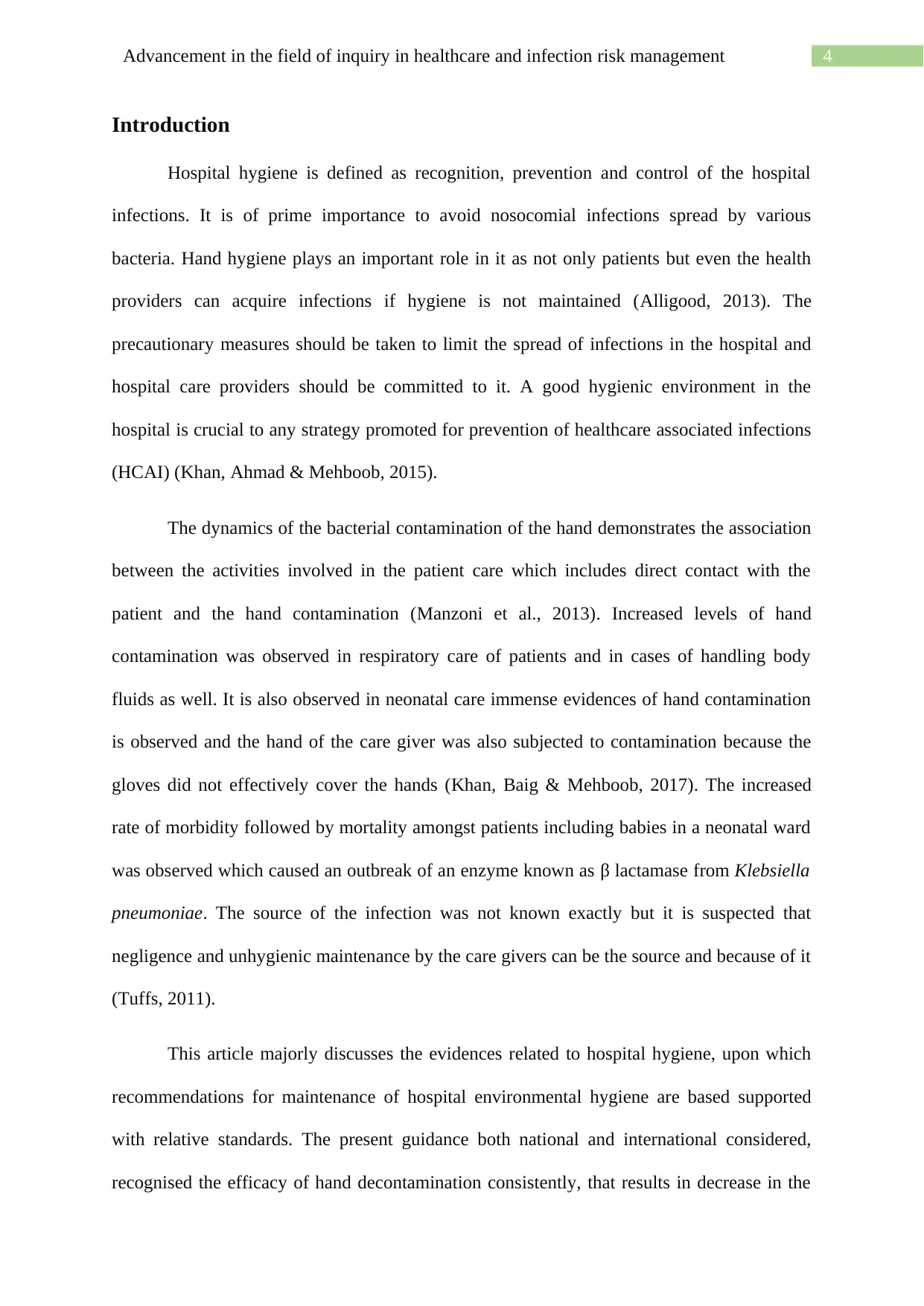
4Advancement in the field of inquiry in healthcare and infection risk management
Introduction
Hospital hygiene is defined as recognition, prevention and control of the hospital
infections. It is of prime importance to avoid nosocomial infections spread by various
bacteria. Hand hygiene plays an important role in it as not only patients but even the health
providers can acquire infections if hygiene is not maintained (Alligood, 2013). The
precautionary measures should be taken to limit the spread of infections in the hospital and
hospital care providers should be committed to it. A good hygienic environment in the
hospital is crucial to any strategy promoted for prevention of healthcare associated infections
(HCAI) (Khan, Ahmad & Mehboob, 2015).
The dynamics of the bacterial contamination of the hand demonstrates the association
between the activities involved in the patient care which includes direct contact with the
patient and the hand contamination (Manzoni et al., 2013). Increased levels of hand
contamination was observed in respiratory care of patients and in cases of handling body
fluids as well. It is also observed in neonatal care immense evidences of hand contamination
is observed and the hand of the care giver was also subjected to contamination because the
gloves did not effectively cover the hands (Khan, Baig & Mehboob, 2017). The increased
rate of morbidity followed by mortality amongst patients including babies in a neonatal ward
was observed which caused an outbreak of an enzyme known as β lactamase from Klebsiella
pneumoniae. The source of the infection was not known exactly but it is suspected that
negligence and unhygienic maintenance by the care givers can be the source and because of it
(Tuffs, 2011).
This article majorly discusses the evidences related to hospital hygiene, upon which
recommendations for maintenance of hospital environmental hygiene are based supported
with relative standards. The present guidance both national and international considered,
recognised the efficacy of hand decontamination consistently, that results in decrease in the
Introduction
Hospital hygiene is defined as recognition, prevention and control of the hospital
infections. It is of prime importance to avoid nosocomial infections spread by various
bacteria. Hand hygiene plays an important role in it as not only patients but even the health
providers can acquire infections if hygiene is not maintained (Alligood, 2013). The
precautionary measures should be taken to limit the spread of infections in the hospital and
hospital care providers should be committed to it. A good hygienic environment in the
hospital is crucial to any strategy promoted for prevention of healthcare associated infections
(HCAI) (Khan, Ahmad & Mehboob, 2015).
The dynamics of the bacterial contamination of the hand demonstrates the association
between the activities involved in the patient care which includes direct contact with the
patient and the hand contamination (Manzoni et al., 2013). Increased levels of hand
contamination was observed in respiratory care of patients and in cases of handling body
fluids as well. It is also observed in neonatal care immense evidences of hand contamination
is observed and the hand of the care giver was also subjected to contamination because the
gloves did not effectively cover the hands (Khan, Baig & Mehboob, 2017). The increased
rate of morbidity followed by mortality amongst patients including babies in a neonatal ward
was observed which caused an outbreak of an enzyme known as β lactamase from Klebsiella
pneumoniae. The source of the infection was not known exactly but it is suspected that
negligence and unhygienic maintenance by the care givers can be the source and because of it
(Tuffs, 2011).
This article majorly discusses the evidences related to hospital hygiene, upon which
recommendations for maintenance of hospital environmental hygiene are based supported
with relative standards. The present guidance both national and international considered,
recognised the efficacy of hand decontamination consistently, that results in decrease in the

5Advancement in the field of inquiry in healthcare and infection risk management
carriage of the contagious pathogens and hence, significantly reduces the HCAI in the
hospitals correspondingly decreasing the rate of morbidity and mortality (Sadule-Rios &
Aguilera, 2017).
Background literature
Nursing theorist, Dorothea Orem Self Care Theory: Self-care defines as those
independent healthy practices that can be pursued by an individual to maintain their health
conditions.it depends totally on an individual to abide by the guidelines of self-care practices.
Washing of hands is included in those self-care practices (Liu et al., 2014). One can prevent
encounter to disease and promoting a healthy life by decontaminating their hands. Nurses
should set an ideal example to maintain proper self-care and promote healthy living
(Asadollahi et al., 2015). Nurses provide education to patients on self-care practices. Hence,
nurses should first embrace self-care practices and apply it themselves before educating
others (Huis et al., 2013). It is unexpected of them to ignore such practices and also
sometimes falls prey to infection related to lack of required safe care practices.
The recent studies show that hand mediated transmission of pathogens and subsequent
infection is a major contributing factor for nosocomial infections (Blum, 2014). This is a
potent threat to the patients in the hospital. These pathogens can be both sensitive to
methicillin sensitive Staphylococcus aureus MSSA and MRSA, it involves multi-resistant
Gram negative species Acinetobacter sp. and vancomycin resistant enterococci. The adverse
clinical outcomes occur due to contamination of contagious infections from one patient to the
other (Salmon et al., 2013).
Primary exogenous infections that a patient get inflicted with is considered to be a
direct threat. In these cases, the microbes are introduced to vulnerable sites like surgical
wound, catheters for urinary discharge, enteral feeding and pulmonary ventilation system for
carriage of the contagious pathogens and hence, significantly reduces the HCAI in the
hospitals correspondingly decreasing the rate of morbidity and mortality (Sadule-Rios &
Aguilera, 2017).
Background literature
Nursing theorist, Dorothea Orem Self Care Theory: Self-care defines as those
independent healthy practices that can be pursued by an individual to maintain their health
conditions.it depends totally on an individual to abide by the guidelines of self-care practices.
Washing of hands is included in those self-care practices (Liu et al., 2014). One can prevent
encounter to disease and promoting a healthy life by decontaminating their hands. Nurses
should set an ideal example to maintain proper self-care and promote healthy living
(Asadollahi et al., 2015). Nurses provide education to patients on self-care practices. Hence,
nurses should first embrace self-care practices and apply it themselves before educating
others (Huis et al., 2013). It is unexpected of them to ignore such practices and also
sometimes falls prey to infection related to lack of required safe care practices.
The recent studies show that hand mediated transmission of pathogens and subsequent
infection is a major contributing factor for nosocomial infections (Blum, 2014). This is a
potent threat to the patients in the hospital. These pathogens can be both sensitive to
methicillin sensitive Staphylococcus aureus MSSA and MRSA, it involves multi-resistant
Gram negative species Acinetobacter sp. and vancomycin resistant enterococci. The adverse
clinical outcomes occur due to contamination of contagious infections from one patient to the
other (Salmon et al., 2013).
Primary exogenous infections that a patient get inflicted with is considered to be a
direct threat. In these cases, the microbes are introduced to vulnerable sites like surgical
wound, catheters for urinary discharge, enteral feeding and pulmonary ventilation system for
⊘ This is a preview!⊘
Do you want full access?
Subscribe today to unlock all pages.

Trusted by 1+ million students worldwide
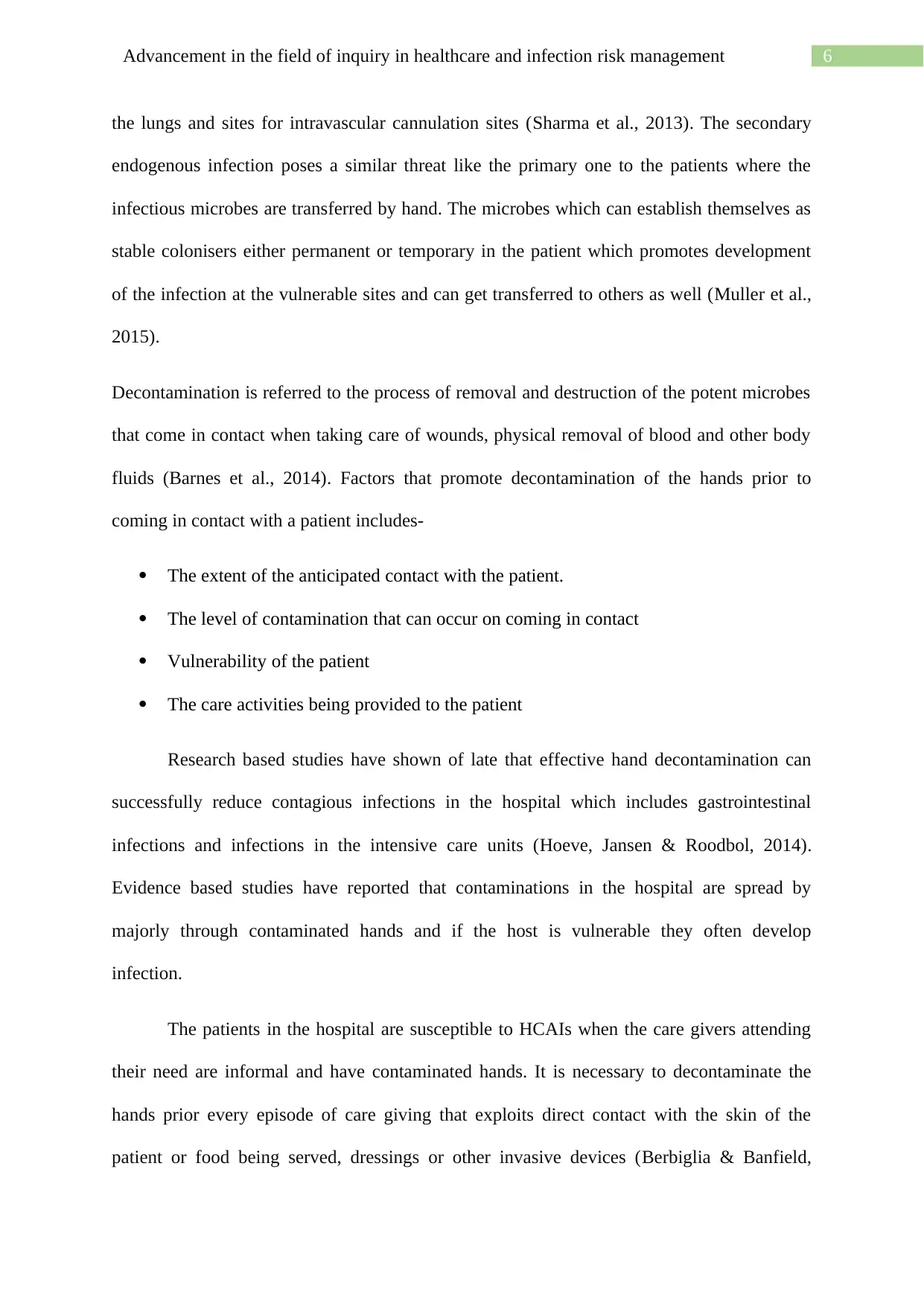
6Advancement in the field of inquiry in healthcare and infection risk management
the lungs and sites for intravascular cannulation sites (Sharma et al., 2013). The secondary
endogenous infection poses a similar threat like the primary one to the patients where the
infectious microbes are transferred by hand. The microbes which can establish themselves as
stable colonisers either permanent or temporary in the patient which promotes development
of the infection at the vulnerable sites and can get transferred to others as well (Muller et al.,
2015).
Decontamination is referred to the process of removal and destruction of the potent microbes
that come in contact when taking care of wounds, physical removal of blood and other body
fluids (Barnes et al., 2014). Factors that promote decontamination of the hands prior to
coming in contact with a patient includes-
The extent of the anticipated contact with the patient.
The level of contamination that can occur on coming in contact
Vulnerability of the patient
The care activities being provided to the patient
Research based studies have shown of late that effective hand decontamination can
successfully reduce contagious infections in the hospital which includes gastrointestinal
infections and infections in the intensive care units (Hoeve, Jansen & Roodbol, 2014).
Evidence based studies have reported that contaminations in the hospital are spread by
majorly through contaminated hands and if the host is vulnerable they often develop
infection.
The patients in the hospital are susceptible to HCAIs when the care givers attending
their need are informal and have contaminated hands. It is necessary to decontaminate the
hands prior every episode of care giving that exploits direct contact with the skin of the
patient or food being served, dressings or other invasive devices (Berbiglia & Banfield,
the lungs and sites for intravascular cannulation sites (Sharma et al., 2013). The secondary
endogenous infection poses a similar threat like the primary one to the patients where the
infectious microbes are transferred by hand. The microbes which can establish themselves as
stable colonisers either permanent or temporary in the patient which promotes development
of the infection at the vulnerable sites and can get transferred to others as well (Muller et al.,
2015).
Decontamination is referred to the process of removal and destruction of the potent microbes
that come in contact when taking care of wounds, physical removal of blood and other body
fluids (Barnes et al., 2014). Factors that promote decontamination of the hands prior to
coming in contact with a patient includes-
The extent of the anticipated contact with the patient.
The level of contamination that can occur on coming in contact
Vulnerability of the patient
The care activities being provided to the patient
Research based studies have shown of late that effective hand decontamination can
successfully reduce contagious infections in the hospital which includes gastrointestinal
infections and infections in the intensive care units (Hoeve, Jansen & Roodbol, 2014).
Evidence based studies have reported that contaminations in the hospital are spread by
majorly through contaminated hands and if the host is vulnerable they often develop
infection.
The patients in the hospital are susceptible to HCAIs when the care givers attending
their need are informal and have contaminated hands. It is necessary to decontaminate the
hands prior every episode of care giving that exploits direct contact with the skin of the
patient or food being served, dressings or other invasive devices (Berbiglia & Banfield,
Paraphrase This Document
Need a fresh take? Get an instant paraphrase of this document with our AI Paraphraser

7Advancement in the field of inquiry in healthcare and infection risk management
2013). According to the recent studies involving nursing care, hand gloves should be
removed and hands should be decontaminated after every episode of care giving (Shinde &
Mohite, 2014).
The most common and epidemiologically important antibiotic resistant bacteria that causes
nosocomial infections is MRSA (Ariyaratne et al., 2015). It is observed that most of the
Staphylococcus aureus infections that occur in the hospitals are resistant to the antibiotic
methicillin. The highest rate of MRSA positivity observed on the tourniquets was opined by
Sacar et al, 2006. The disposable tourniquets are recommended to maintain the hygiene in
patients taking shelter in the hospital. This also decreases the risk of cross infection via
tourniquets.
The most important means of reducing the cases of cross contamination in hospitals is
by washing of hands. This is a simple self-care practice but often ignored and has poor
compliance to. Usage of gloves for care givers is also promoted (Seto et al., 2013). The
purpose of gloves is to provide a two-way protection, it prevents transmission of the
infections to the patients from the care giver and also prevents the health care personnel from
getting infected due to contact with the patient’s blood, other body fluids or even the surface
of the affected area (Jones et al., 2017). But it is observed that there is noncompliance in
changing the hand gloves after each episode of care giving.
Research methodology
The participants of this research article will be the nurses from a recognised health
facility centre. The attempt of data collection will approximately be targeted within a week.
Prior to the conduction of the research a preliminary visit to the health facility should be done
in order to get the required permission to conduct the survey and to get familiar with the
respondents.
2013). According to the recent studies involving nursing care, hand gloves should be
removed and hands should be decontaminated after every episode of care giving (Shinde &
Mohite, 2014).
The most common and epidemiologically important antibiotic resistant bacteria that causes
nosocomial infections is MRSA (Ariyaratne et al., 2015). It is observed that most of the
Staphylococcus aureus infections that occur in the hospitals are resistant to the antibiotic
methicillin. The highest rate of MRSA positivity observed on the tourniquets was opined by
Sacar et al, 2006. The disposable tourniquets are recommended to maintain the hygiene in
patients taking shelter in the hospital. This also decreases the risk of cross infection via
tourniquets.
The most important means of reducing the cases of cross contamination in hospitals is
by washing of hands. This is a simple self-care practice but often ignored and has poor
compliance to. Usage of gloves for care givers is also promoted (Seto et al., 2013). The
purpose of gloves is to provide a two-way protection, it prevents transmission of the
infections to the patients from the care giver and also prevents the health care personnel from
getting infected due to contact with the patient’s blood, other body fluids or even the surface
of the affected area (Jones et al., 2017). But it is observed that there is noncompliance in
changing the hand gloves after each episode of care giving.
Research methodology
The participants of this research article will be the nurses from a recognised health
facility centre. The attempt of data collection will approximately be targeted within a week.
Prior to the conduction of the research a preliminary visit to the health facility should be done
in order to get the required permission to conduct the survey and to get familiar with the
respondents.

8Advancement in the field of inquiry in healthcare and infection risk management
Sample size: The sample size for the research article would be approximately
ten nurses and the selection procedure would ensure random selection amongst
the nurses present in the health facility. These selected nurses will act as the
representatives of the nurse population in the centre.
Sample Data Collection: The data collection method exploited will mainly be
primary data collection process. It would exploit direct interviews and
observations of their work. The interviews with the health care personnel
would help to conclude the level of compliance to self-care that they exercise
regularly. The questions that are considered to be too personnel will be
avoided. The observation techniques that would be exploited include the
pattern of washing their hands, practices nurtured by them after exiting from
the rest room, during meals and while handling with patients. These recorded
data collected will be analysed.
A chart will be formed on the basis of the result which would depict the number of
nurses that were in compliance to good self-care as well as patient care practices. the table
would consist of subjects like hand wash after exiting the rest room, prior to meal intake,
when administering routine care to patients etc. Post analysis results will be projected to the
tested population of nurses. The study will be majorly based on the compliance with
maintenance of hygiene with respect to washing of hands. This will promote self-care
practices and also practices of maintaining required hygiene while handling patients.
Expected outcome: Based on the results obtained it is anticipated that the
nurses of the proposed health facility centre do not perceive to hygienic hand
wash facilities. The recent articles related to the spread of nosocomial infections
and depleted health condition in the neonatal ward are a raising concern that
doubts the hygienic maintenance of the hospital staff. The high and increasing
Sample size: The sample size for the research article would be approximately
ten nurses and the selection procedure would ensure random selection amongst
the nurses present in the health facility. These selected nurses will act as the
representatives of the nurse population in the centre.
Sample Data Collection: The data collection method exploited will mainly be
primary data collection process. It would exploit direct interviews and
observations of their work. The interviews with the health care personnel
would help to conclude the level of compliance to self-care that they exercise
regularly. The questions that are considered to be too personnel will be
avoided. The observation techniques that would be exploited include the
pattern of washing their hands, practices nurtured by them after exiting from
the rest room, during meals and while handling with patients. These recorded
data collected will be analysed.
A chart will be formed on the basis of the result which would depict the number of
nurses that were in compliance to good self-care as well as patient care practices. the table
would consist of subjects like hand wash after exiting the rest room, prior to meal intake,
when administering routine care to patients etc. Post analysis results will be projected to the
tested population of nurses. The study will be majorly based on the compliance with
maintenance of hygiene with respect to washing of hands. This will promote self-care
practices and also practices of maintaining required hygiene while handling patients.
Expected outcome: Based on the results obtained it is anticipated that the
nurses of the proposed health facility centre do not perceive to hygienic hand
wash facilities. The recent articles related to the spread of nosocomial infections
and depleted health condition in the neonatal ward are a raising concern that
doubts the hygienic maintenance of the hospital staff. The high and increasing
⊘ This is a preview!⊘
Do you want full access?
Subscribe today to unlock all pages.

Trusted by 1+ million students worldwide
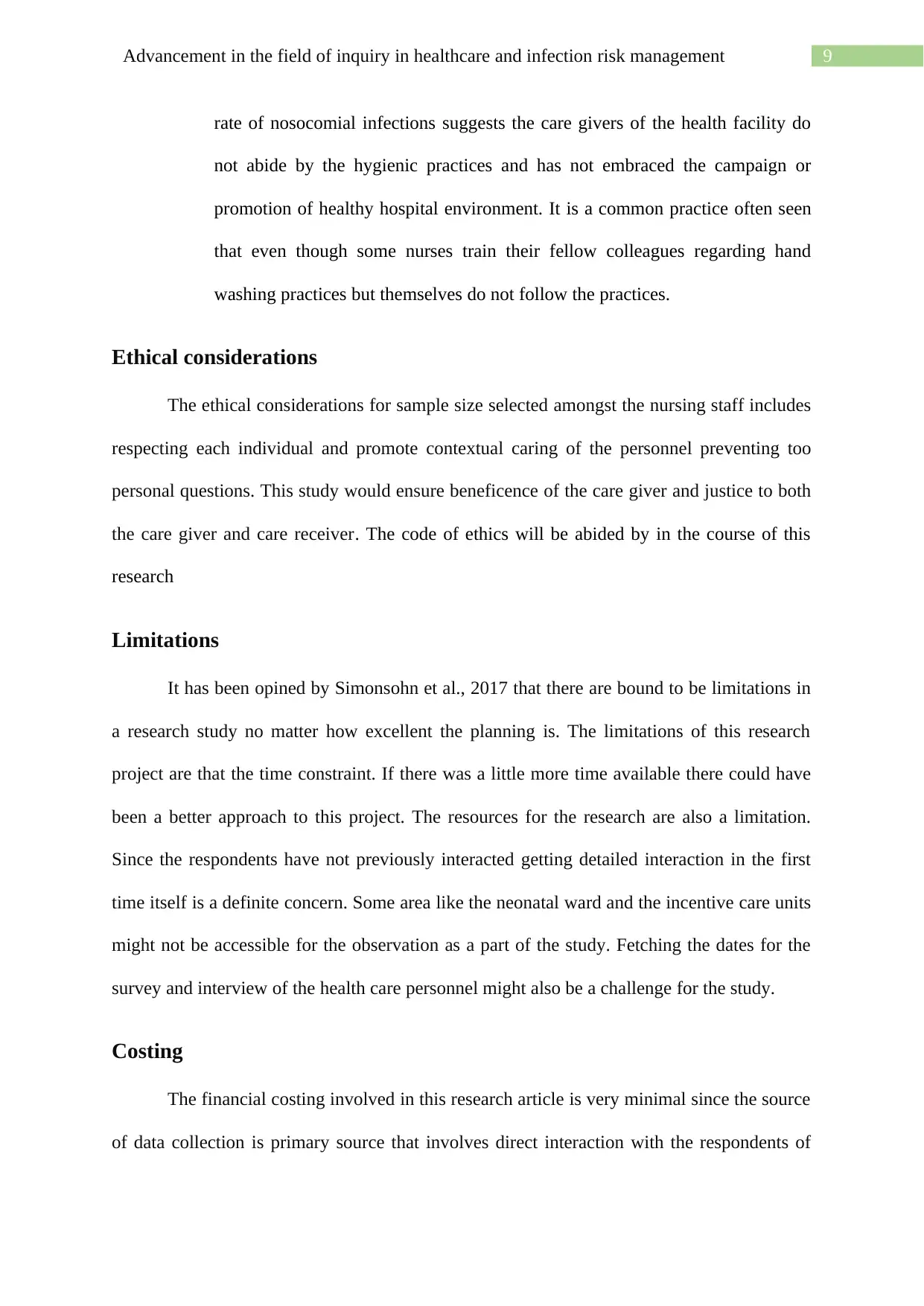
9Advancement in the field of inquiry in healthcare and infection risk management
rate of nosocomial infections suggests the care givers of the health facility do
not abide by the hygienic practices and has not embraced the campaign or
promotion of healthy hospital environment. It is a common practice often seen
that even though some nurses train their fellow colleagues regarding hand
washing practices but themselves do not follow the practices.
Ethical considerations
The ethical considerations for sample size selected amongst the nursing staff includes
respecting each individual and promote contextual caring of the personnel preventing too
personal questions. This study would ensure beneficence of the care giver and justice to both
the care giver and care receiver. The code of ethics will be abided by in the course of this
research
Limitations
It has been opined by Simonsohn et al., 2017 that there are bound to be limitations in
a research study no matter how excellent the planning is. The limitations of this research
project are that the time constraint. If there was a little more time available there could have
been a better approach to this project. The resources for the research are also a limitation.
Since the respondents have not previously interacted getting detailed interaction in the first
time itself is a definite concern. Some area like the neonatal ward and the incentive care units
might not be accessible for the observation as a part of the study. Fetching the dates for the
survey and interview of the health care personnel might also be a challenge for the study.
Costing
The financial costing involved in this research article is very minimal since the source
of data collection is primary source that involves direct interaction with the respondents of
rate of nosocomial infections suggests the care givers of the health facility do
not abide by the hygienic practices and has not embraced the campaign or
promotion of healthy hospital environment. It is a common practice often seen
that even though some nurses train their fellow colleagues regarding hand
washing practices but themselves do not follow the practices.
Ethical considerations
The ethical considerations for sample size selected amongst the nursing staff includes
respecting each individual and promote contextual caring of the personnel preventing too
personal questions. This study would ensure beneficence of the care giver and justice to both
the care giver and care receiver. The code of ethics will be abided by in the course of this
research
Limitations
It has been opined by Simonsohn et al., 2017 that there are bound to be limitations in
a research study no matter how excellent the planning is. The limitations of this research
project are that the time constraint. If there was a little more time available there could have
been a better approach to this project. The resources for the research are also a limitation.
Since the respondents have not previously interacted getting detailed interaction in the first
time itself is a definite concern. Some area like the neonatal ward and the incentive care units
might not be accessible for the observation as a part of the study. Fetching the dates for the
survey and interview of the health care personnel might also be a challenge for the study.
Costing
The financial costing involved in this research article is very minimal since the source
of data collection is primary source that involves direct interaction with the respondents of
Paraphrase This Document
Need a fresh take? Get an instant paraphrase of this document with our AI Paraphraser
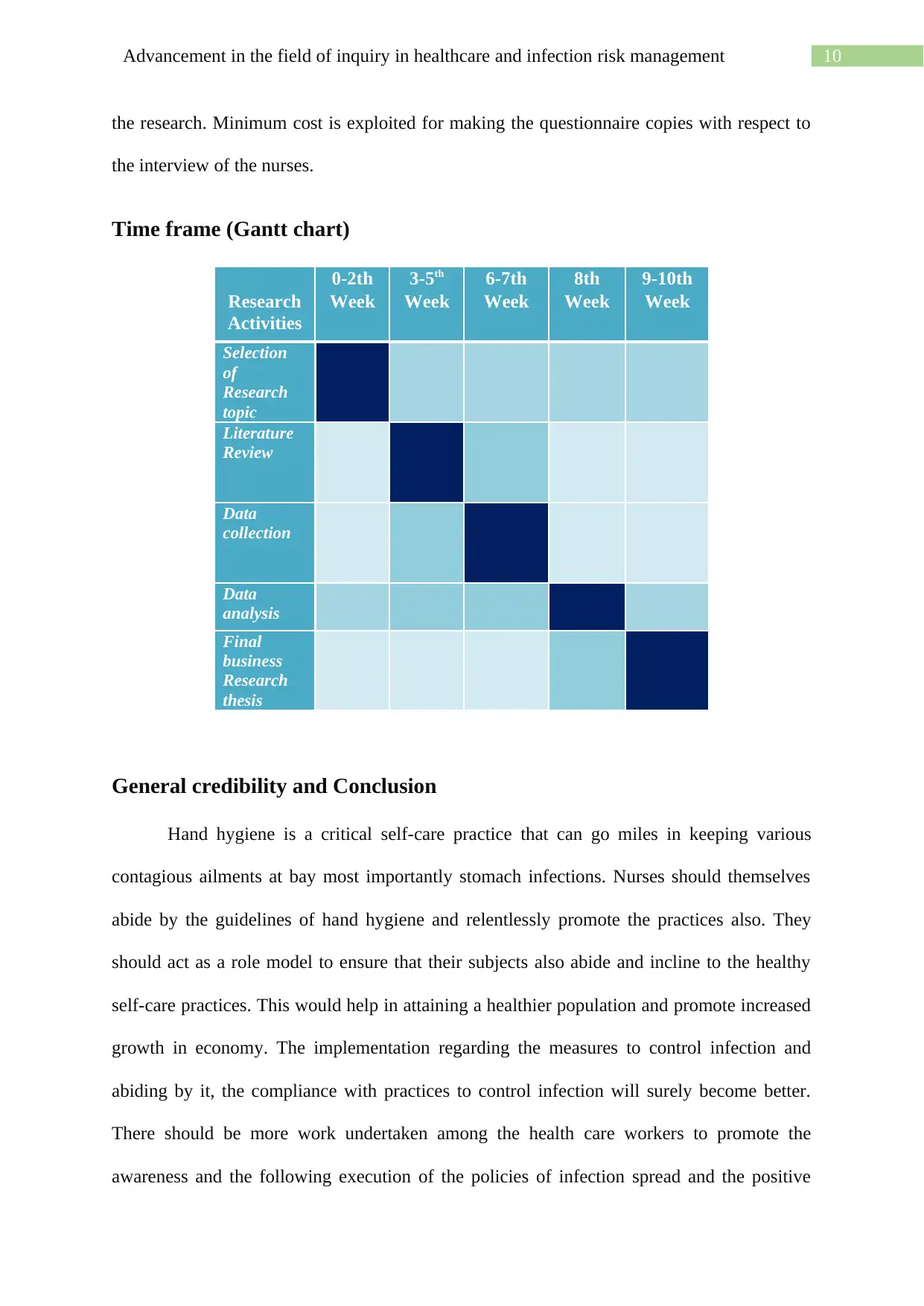
10Advancement in the field of inquiry in healthcare and infection risk management
the research. Minimum cost is exploited for making the questionnaire copies with respect to
the interview of the nurses.
Time frame (Gantt chart)
0-2th 3-5th 6-7th 8th 9-10th
Research
Activities
Week Week Week Week Week
Selection
of
Research
topic
Literature
Review
Data
collection
Data
analysis
Final
business
Research
thesis
General credibility and Conclusion
Hand hygiene is a critical self-care practice that can go miles in keeping various
contagious ailments at bay most importantly stomach infections. Nurses should themselves
abide by the guidelines of hand hygiene and relentlessly promote the practices also. They
should act as a role model to ensure that their subjects also abide and incline to the healthy
self-care practices. This would help in attaining a healthier population and promote increased
growth in economy. The implementation regarding the measures to control infection and
abiding by it, the compliance with practices to control infection will surely become better.
There should be more work undertaken among the health care workers to promote the
awareness and the following execution of the policies of infection spread and the positive
the research. Minimum cost is exploited for making the questionnaire copies with respect to
the interview of the nurses.
Time frame (Gantt chart)
0-2th 3-5th 6-7th 8th 9-10th
Research
Activities
Week Week Week Week Week
Selection
of
Research
topic
Literature
Review
Data
collection
Data
analysis
Final
business
Research
thesis
General credibility and Conclusion
Hand hygiene is a critical self-care practice that can go miles in keeping various
contagious ailments at bay most importantly stomach infections. Nurses should themselves
abide by the guidelines of hand hygiene and relentlessly promote the practices also. They
should act as a role model to ensure that their subjects also abide and incline to the healthy
self-care practices. This would help in attaining a healthier population and promote increased
growth in economy. The implementation regarding the measures to control infection and
abiding by it, the compliance with practices to control infection will surely become better.
There should be more work undertaken among the health care workers to promote the
awareness and the following execution of the policies of infection spread and the positive
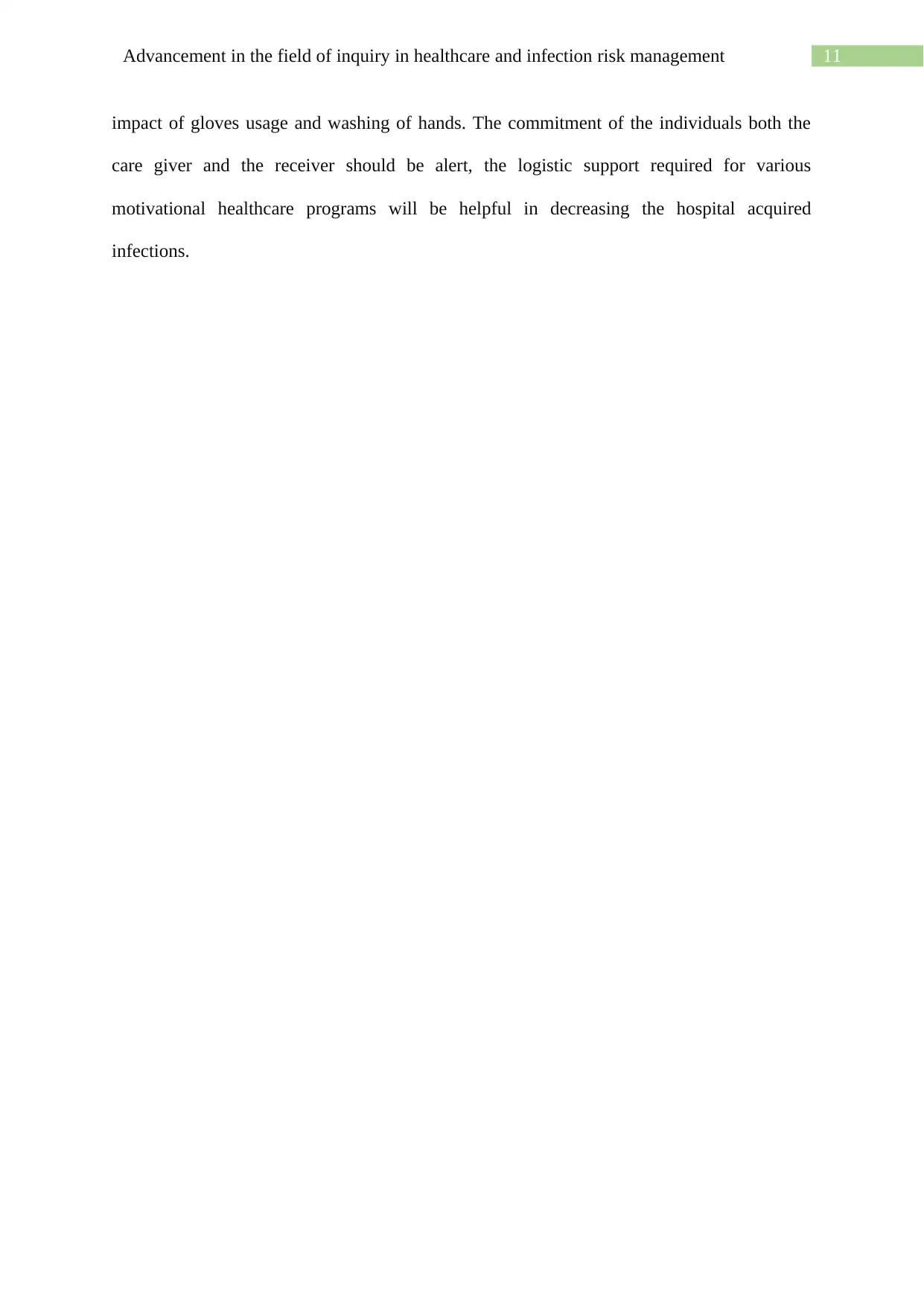
11Advancement in the field of inquiry in healthcare and infection risk management
impact of gloves usage and washing of hands. The commitment of the individuals both the
care giver and the receiver should be alert, the logistic support required for various
motivational healthcare programs will be helpful in decreasing the hospital acquired
infections.
impact of gloves usage and washing of hands. The commitment of the individuals both the
care giver and the receiver should be alert, the logistic support required for various
motivational healthcare programs will be helpful in decreasing the hospital acquired
infections.
⊘ This is a preview!⊘
Do you want full access?
Subscribe today to unlock all pages.

Trusted by 1+ million students worldwide
1 out of 16
Related Documents
Your All-in-One AI-Powered Toolkit for Academic Success.
+13062052269
info@desklib.com
Available 24*7 on WhatsApp / Email
![[object Object]](/_next/static/media/star-bottom.7253800d.svg)
Unlock your academic potential
Copyright © 2020–2025 A2Z Services. All Rights Reserved. Developed and managed by ZUCOL.





